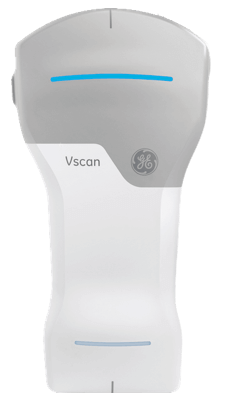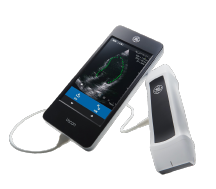Handheld cardiac ultrasound does not aim to replace routine comprehensive echocardiography, but its use may decrease the frequency of comprehensive scans. As a result, it might not only make clinicians’ lives easier, but it may also lead to better patient experiences and outcomes.
Making a Cardiology Diagnosis
There are many applications for handheld ultrasound in making a cardiology diagnosis. For example, it may be used specifically to assess cardiac chamber size and function and valvular regurgitation. An article in Clinical Cardiology reported that “the pocket-sized [portable transthoracic echo (pTTE)] provides accurate detection of cardiac structural and functional abnormalities beyond the [electrocardiogram (ECG)]. In addition, the use of pTTE as an initial screening tool prior to [standard TTE] is cost-effective, suggesting that the pocket-sized pTTE is poised to alter the current diagnostic strategy in clinical practice.”
Non-cardiologists may use handheld ultrasound as a tool for aortic stenosis and mitral regurgitation. This means that the ultrasound may be an adjunct to clinical examination in patients where a murmur is heard. Wiener Klinische Wochenschrift reports, “Pocket-size ultrasound imaging devices without continuous and pulse wave Doppler modalities can, even in the hands of a non-cardiologist with limited cardiac ultrasound instructions with high sensitivity and specificity, be a useful tool for detecting more than mild aortic stenosis and more than mild mitral regurgitation.”
Handheld ultrasound may also be used to assess the volume status of the patient, via the inferior vena cava (IVC) diameter, as an indicator of progression of heart failure. As discussed in the American Journal of Cardiology, this use of ultrasound “is associated with an increased risk of heart failure admission and may provide clinically useful information at the point of care to guide heart failure management.”
Augmenting Workflow
Handheld ultrasound may be used by primary care physicians to detect cardiovascular disease, and this may decrease the number of unnecessary formal echocardiograms. One study, published in Heart, used remote expert support to help interpret the handheld ultrasound images and found it to be “rapid and useful for detecting significant echocardiographic abnormalities and reducing the number of unnecessary echocardiographic studies.”
Having repeat formal transthoracic echocardiograms (TTEs) to detect problems such as impaired ventricular function, pericardial effusion and IVC collapse is common. Using handheld, focused ultrasound scans of the heart may reduce the need for so many follow-up TTEs in a short space of time. A paper in the Journal of the American Society of Echocardiography concluded that “[t]he judicious use of expert focused cardiac ultrasound in place of repeat inpatient TTE has the potential to deliver quality cardiac imaging at reduced cost.”
In some patients who are acutely unwell, moving them into a good position in their bed for a formal echocardiogram could be challenging. Handheld ultrasound may have an advantage as it can be used on patients in a semi-recumbent position. An article in Acta Anaesthesiologica Scandinavia concluded that “[t]he apparatus is well-suited for performing a [focus-assessed transthoracic echocardiography] examination in a one-day surgery setting and could very well also be applicable in almost any situation involving patients with acute illness.”
Streamlining Care
What’s more, handheld ultrasound may be used by cardiologists on their ward rounds. Being able to do a bedside ultrasound may reduce the number of formal echo studies that need to be done. As described in the American Journal of Medicine, “For hospitalized patients, [t]his finding could shift the burden of performing and interpreting the echocardiogram to the examining physician and reduce the number and cost associated with formal echocardiography studies.”
In emergency departments, handheld ultrasound may reduce the time to diagnosis in patients presenting with shortness of breath. Herz reported, “One-third of patients had significant findings on the scans to possibly aid diagnosis and prevent misdiagnosis. This has the potential to reduce time to diagnosis in the [emergency department].”
Handheld ultrasound may be used by a broad range of healthcare professionals in different specialties to help streamline patient care, improve diagnosis and direct therapy — and it might be a beneficial adjunct to formal echocardiography.




